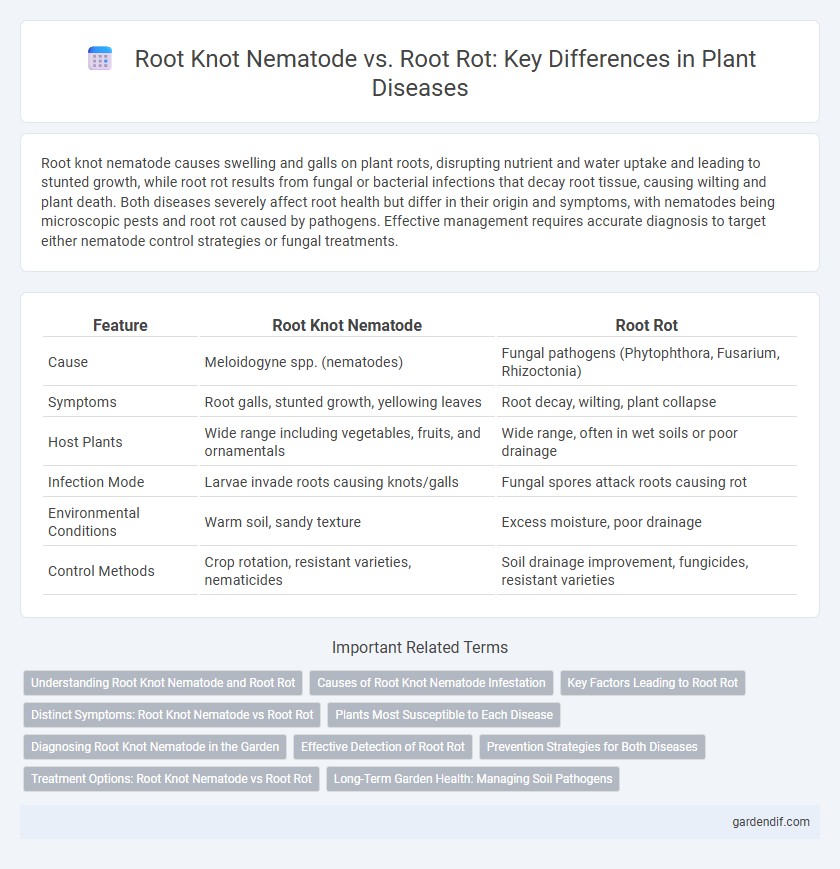
Root knot nematode vs Root rot Illustration
Root knot nematode causes swelling and galls on plant roots, disrupting nutrient and water uptake and leading to stunted growth, while root rot results from fungal or bacterial infections that decay root tissue, causing wilting and plant death. Both diseases severely affect root health but differ in their origin and symptoms, with nematodes being microscopic pests and root rot caused by pathogens. Effective management requires accurate diagnosis to target either nematode control strategies or fungal treatments.
Table of Comparison
| Feature | Root Knot Nematode | Root Rot |
|---|---|---|
| Cause | Meloidogyne spp. (nematodes) | Fungal pathogens (Phytophthora, Fusarium, Rhizoctonia) |
| Symptoms | Root galls, stunted growth, yellowing leaves | Root decay, wilting, plant collapse |
| Host Plants | Wide range including vegetables, fruits, and ornamentals | Wide range, often in wet soils or poor drainage |
| Infection Mode | Larvae invade roots causing knots/galls | Fungal spores attack roots causing rot |
| Environmental Conditions | Warm soil, sandy texture | Excess moisture, poor drainage |
| Control Methods | Crop rotation, resistant varieties, nematicides | Soil drainage improvement, fungicides, resistant varieties |
Understanding Root Knot Nematode and Root Rot
Root knot nematode is a parasitic roundworm that infects plant roots, causing characteristic galls that disrupt nutrient and water uptake, leading to stunted growth and yield loss. Root rot is a fungal or oomycete disease that causes decay of root tissues, often resulting in wilting, yellowing, and eventual plant death due to impaired root function. Differentiating these diseases involves examining root symptoms: nematode infestation forms distinct root knots, while root rot presents with soft, discolored roots and a deteriorated root system.
Causes of Root Knot Nematode Infestation
Root knot nematode infestation is primarily caused by microscopic parasitic roundworms known as Meloidogyne species, which invade plant roots and induce the formation of characteristic galls or knots. These nematodes thrive in warm, sandy soils with poor crop rotation practices, allowing their populations to increase rapidly and damage root systems. Infection disrupts water and nutrient uptake, leading to stunted growth and reduced crop yields, distinguishing it from root rot caused by fungal pathogens.
Key Factors Leading to Root Rot
Key factors leading to root rot include excessive soil moisture, poor drainage, and the presence of pathogenic fungi such as Phytophthora, Pythium, and Fusarium species. Root rot primarily occurs in waterlogged soils where oxygen availability is low, creating ideal conditions for these pathogens to infect and decay plant roots. In contrast to the root knot nematode, which causes galls and disrupts nutrient uptake, root rot results in widespread root tissue necrosis and plant wilting.
Distinct Symptoms: Root Knot Nematode vs Root Rot
Root knot nematode causes swollen, knotted galls on roots disrupting nutrient uptake, while root rot results in dark, mushy, decayed root tissues leading to plant wilt and yellowing. Infected plants by root knot nematode exhibit stunted growth and nutrient deficiency symptoms, contrasting with root rot's characteristic root tissue breakdown and foul odor. Distinguishing these symptoms aids in accurate diagnosis and targeted disease management in crops.
Plants Most Susceptible to Each Disease
Root knot nematodes primarily target vegetables such as tomatoes, carrots, and potatoes, causing galls on roots that inhibit nutrient uptake. Root rot commonly affects crops like soybeans, sugar beets, and alfalfa, leading to decayed roots and poor water absorption. Understanding host susceptibility supports effective disease management and crop rotation planning.
Diagnosing Root Knot Nematode in the Garden
Diagnosing root knot nematode in the garden involves observing characteristic galls or swellings on plant roots caused by Meloidogyne species, which disrupt nutrient uptake and lead to stunted growth and yellowing leaves. Unlike root rot, caused by soil-borne fungi such as Phytophthora or Pythium, root knot nematodes produce distinct root deformities rather than widespread root decay or softening. Soil sampling and microscopic examination of root tissues help confirm the presence of nematode larvae, enabling precise identification and targeted management strategies.
Effective Detection of Root Rot
Effective detection of root rot relies on early identification of symptoms such as dark, mushy roots and stunted plant growth, often confirmed through laboratory analysis of root samples for fungal pathogens like Phytophthora and Pythium species. Advanced techniques such as molecular assays, including PCR, provide precise identification of root rot pathogens, enabling targeted management strategies. Differentiating root rot from root knot nematode infestation is critical, as nematodes cause galls on roots, whereas root rot is characterized by tissue decay, guiding appropriate treatment decisions.
Prevention Strategies for Both Diseases
Effective prevention strategies for root knot nematode include crop rotation with resistant varieties, soil solarization, and the use of organic amendments to enhance soil health. Root rot prevention focuses on proper drainage, avoiding overwatering, and applying fungicidal treatments when necessary to reduce pathogen buildup in the soil. Implementing integrated pest management (IPM) practices helps control both diseases by promoting soil biodiversity and minimizing pathogen proliferation.
Treatment Options: Root Knot Nematode vs Root Rot
Root knot nematode treatment options include crop rotation with non-host plants, soil solarization, and nematicides to reduce nematode populations effectively. Root rot management primarily involves improving soil drainage, applying fungicides, and using resistant plant varieties to combat fungal pathogens. Integrated pest management combining cultural practices and chemical controls offers the best results for both root knot nematode and root rot diseases.
Long-Term Garden Health: Managing Soil Pathogens
Root knot nematodes damage plant roots by creating galls that disrupt nutrient and water uptake, leading to stunted growth and reduced yields. Root rot, caused by fungal pathogens such as Phytophthora and Pythium, results in decaying roots and poor plant vitality. Effective long-term garden health requires crop rotation, soil solarization, and the use of resistant plant varieties to manage these soil-borne pathogens and restore soil microbial balance.
Root knot nematode vs Root rot Infographic

 gardendif.com
gardendif.com